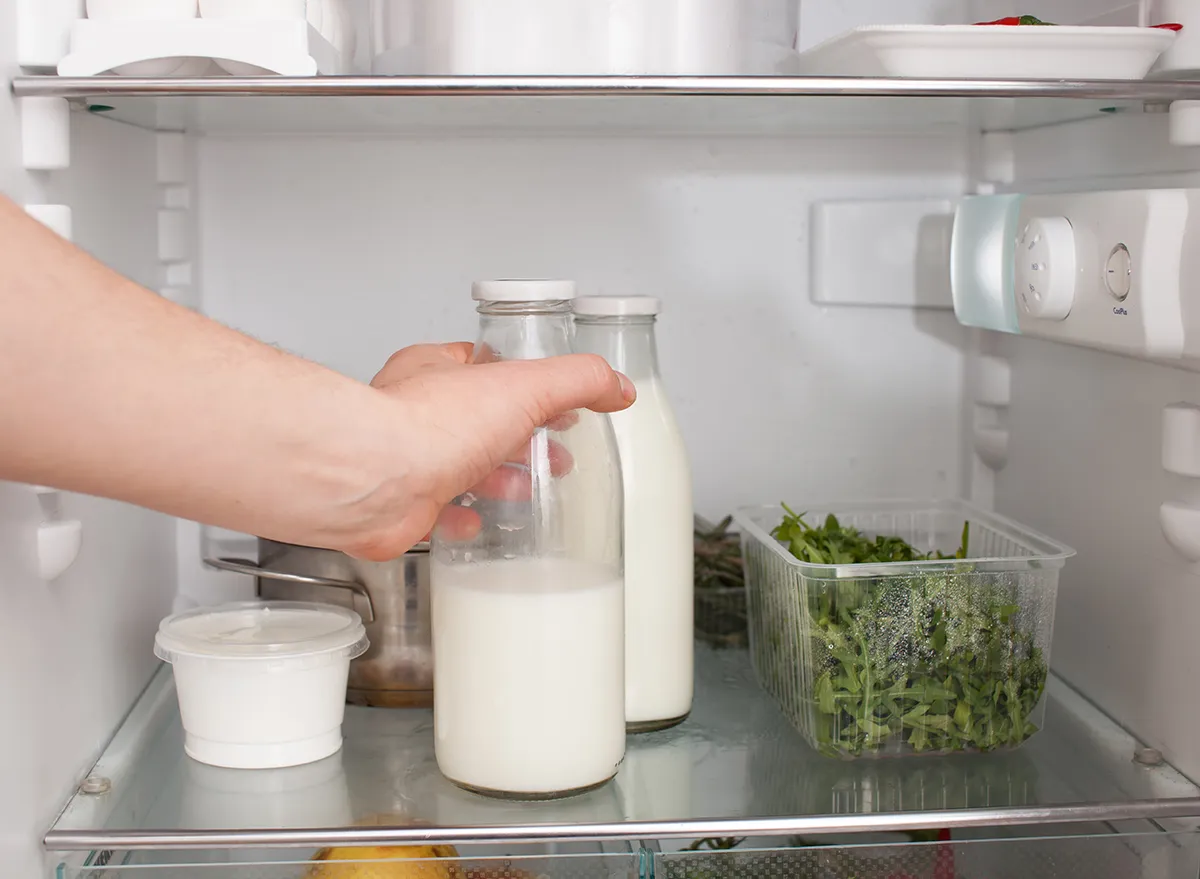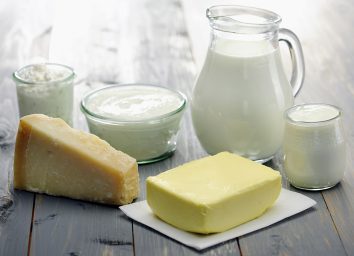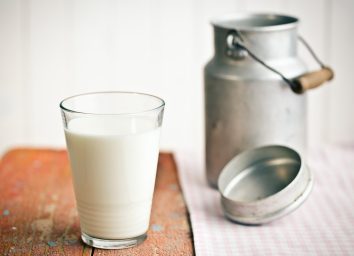Lactose-Free Milk Solved My Bloating—It Could Work For You, Too

I am in denial. I’m in denial about the fact that I am (likely) lactose-intolerant. Growing up in the Midwest, dairy has always been a big part of my diet. We always doused bowls of cereal in milk, poured cream in our coffee, and buttered bagels. In the summer, there were countless trips to local dairies for the freshest ice cream.
But as I’ve gotten older, I’ve realized my denial, and I’m not gonna lie to myself anymore—dairy hurts my stomach.
While I’ve never undergone testing or elimination diets to find out if I’m for sure lactose intolerant, it’s just one of those things I now know about my body: dairy doesn’t agree with me like it used to. Every vanilla latte from Starbucks now leaves my stomach gurgly. Ice cream trips are now accompanied by bad bloating (followed by gas). My morning oatmeal with milk has made me run to the bathroom on multiple occasions.
Milk alternatives may be a solution, but they don’t stack up to dairy milk nutritionally—and the flavor just isn’t the same.
I know what you’re thinking—why not just try one of the dozens of alternative-milks that exist out there? And my answer is, I have. I’ve tried soy, almond, and hemp—you name it. But as a health writer, I’ve been told numerous times that these milk alternatives in no way stack up to the nutritional profile of cow’s milk. They are either packed with sugar, lack essential vitamins and nutrients (specifically calcium and vitamin D), and to be honest—the flavor just didn’t do it for me. So I’ve just kind of been sticking it out—until recently.
After discussing my gut issues with my mom, she was shocked that I’d never tried lactose-free milk. While no one else in my family has confirmed lactose intolerance, they’re big fans of Fairlife milk, an ultra-filtered, lactose-free milk. I was definitely open to giving it a try.
On my next shopping trip at Aldi, I was shocked that they had three different versions of lactose-free milk: skim, 2% and whole. Clearly, I was behind on the trend. I grabbed the 2% carton and started using it the next morning when I made my oatmeal. Of course, I was curious if it would smell or taste the same and have the same texture. I opened the carton, and nothing was noticeably different from the milk I knew and loved. I poured it in my oatmeal, cooked it up, and took my first bite.
How I felt after my first lactose-free milk experience.
All I can say is wow—it tastes the exact same as normal milk. Literally no difference. But the real test would be to see how my stomach reacted. Specifically, if I experienced any gurgling or bloating.
People, I was all good. I go through a half gallon a week now, and I preach to all my friends that it’s truly the God-send my gut needed.
But I still hadn’t done a ton of research on what lactose-free milk actually is. So I reached out to a registered dietitian nutritionist to get the lowdown.
What is lactose-free milk?
“Lactose-free milk is a commercial milk product that doesn’t have lactose, a type of sugar found in dairy products that can be difficult for some people to digest,” says Jerlyn Jones, MS, MPA, RDN, LD, CLT, registered dietitian nutritionist and spokesperson for the Academy of Nutrition and Dietetics.
“Lactose-free milk is a good alternative to regular milk for anyone who is lactose intolerant and suffers from gas, bloating, stomach cramps, nausea, and diarrhea after consuming dairy products,” Jones adds.
What’s the difference between lactose-free milk and regular dairy milk?
The difference between lactose-free milk and regular cow’s milk is lactase.
“Lactase is an enzyme produced in the small intestine and breaks down lactose in the body. Food manufacturers add lactase to regular milk to make lactose-free milk,” says Jones. “Lactose-free milk has nearly the same taste, texture, and nutrient profile as regular milk. It has the same number of calories, protein, fat, and carbohydrate content.”
People who are lactose-intolerant lack the enzyme lactase. Without lactase, your body suffers from malabsorption of lactose, which leads to fermentation in the gut that causes all of the unpleasant symptoms of lactose intolerance, including:
- Abdominal pain
- Diarrhea
- Bloating
- Flatulence
- Other gastrointestinal symptoms
What are the benefits?
Of course, if you have lactose intolerance, lactose-free milk is a fantastic option if you hope to keep drinking dairy milk.
“Drinking lactose-free milk benefits those who are lactose intolerant due to a lactase deficiency,” says Jones.
According to the National Institute of Diabetes and Digestive and Kidney Diseases (NIDDK) an estimated 30 to 50 million Americans are lactose intolerant. Lactose intolerance is more common in some ethnic groups than others, and the NIDDK estimates that up to 75% of all adult African Americans and Native Americans and 90% of Asian Americans are lactose intolerant.
“Lactose-free milk makes digestion easier and is a great source of protein, consisting of about 8 grams in 1 cup and also high in calcium, phosphorus, Vitamin B12, riboflavin, and may be fortified with Vitamin D,” says Jones.
What are the downsides?
Unfortunately, lactose-free milk is more expensive than normal dairy milk.
“Cost is one of the downsides of lactose-free milk. Depending on the brand, the price of lactose-free milk can cost twice as much as regular milk,” says Jones. “It’s not as affordable as regular milk and may not be readily available at every grocery store.”
You may notice lactose-free milk tastes sweeter than regular milk. (Although I couldn’t tell a difference!)
“Lactose-free milk is sweeter because lactase breaks lactose down into two simple sugars: glucose and galactose. Our taste buds perceive these simple sugars as sweeter than complex sugars, therefore giving lactose-free milk a sweeter flavor than regular milk,” says Jones.
Should you give lactose-free milk a try?
If you’re like me and notice drinking or eating regular dairy upsets your stomach, lactose-free milk could be a great option. And if you are lactose-intolerant, this milk should be good for you.
However, according to Jones, because lactose-free milk comes from cow’s milk, it’s not suitable for:
- Anyone with a dairy/milk allergy
- Individuals following a vegan lifestyle
- Individuals following a dairy-free diet (which is different from lactose-free)
- Highly lactose-sensitive individuals
Additionally, lactose-free isn’t the same as lactose-reduced.
“The terms lactose-free and lactose-reduced have different meanings, and a lactose-reduced product may still contain lactose that could cause symptoms,” says Jones.
What ingredients to look out for if you’re avoiding lactose.
She suggests you should always look at the ingredient label if you want to stay away from lactose. If an ingredient label contains any of the following words, the product probably contains lactose, and you should avoid them if you’re lactose intolerant:
- Milk
- Cream
- Butter
- Evaporated milk
- Condensed milk
- Dried milk
- Powdered milk
- Milk solids
- Margarine
- Cheese
- Whey
- Curds








